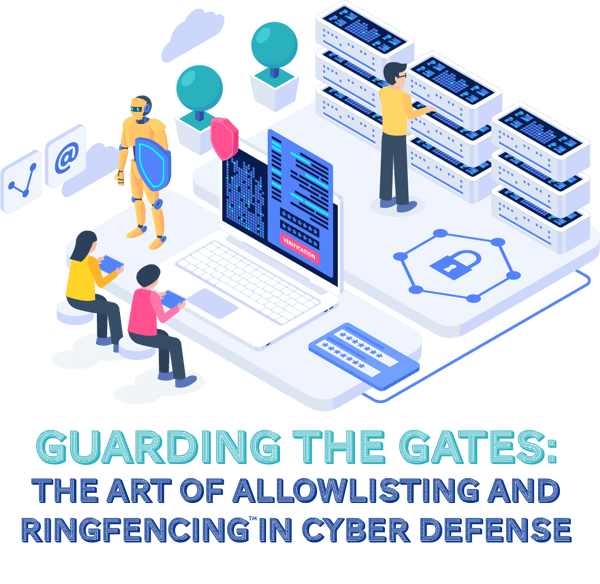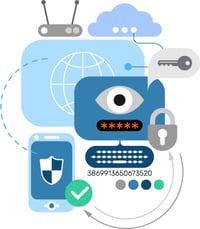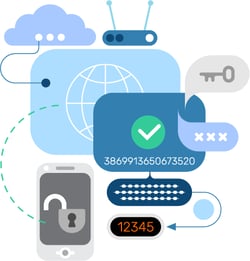Guarding the Gates: Allowlisting and Ringfencing™ in Cyber Defense
In the current digital landscape, every organization finds itself susceptible to cyber threats, and the absence of robust security measures undoubtedly jeopardizes its operations, credibility, reputation, and financial stability.
robust security measures undoubtedly jeopardizes its operations, credibility, reputation, and financial stability.
As the scarcity of cybersecurity talent, knowledge, and expertise continues to escalate, it presents a mounting predicament for most businesses — how can they effectively recognize and address digital risks and build secure, resilient systems? Additionally, how can you protect data in a way that prioritizes privacy but still limits the monumental impacts of a potential attack?
The consensus suggests that companies must cultivate a proactive, forward-looking mindset to thrive in the face of impending disruptions, and this journey can kick off immediately. The good news is that the Zero-Trust approach offers many strategies to fortify your organization's resilience against external cyber threats, beginning with implementing measures like allowlisting and Ringfencing™.
With that in mind, let's dig deeper into these two techniques and examine how they could revolutionize your cybersecurity competencies.
Allowlisting
Allowlisting is a vital security measure that shields your organization against harmful attacks by permitting only trusted files, applications, and processes to run. You can deploy application allowlisting to safeguard your applications from unauthorized threats, effectively creating a protective perimeter that executes known files and processes while blocking unfamiliar ones. Regarding blocked files, your security team can manually review and approve them or automate this workflow through defined controls and policies.
 Allowlisting is highly effective in preventing unauthorized activities and protecting corporate assets, trade secrets, intellectual property, and sensitive data. Moreover, it dramatically minimizes downtime by automating approval procedures — eliminating the need for manual allowlist management in many cases.
Allowlisting is highly effective in preventing unauthorized activities and protecting corporate assets, trade secrets, intellectual property, and sensitive data. Moreover, it dramatically minimizes downtime by automating approval procedures — eliminating the need for manual allowlist management in many cases.
Ringfencing™
When we install an application, even one we trust, it acquires the ability to operate within its defined capabilities. This concept of trust often appears as an all-or-nothing decision, a simplification that doesn't fully encapsulate the intricacies of the real world. Ringfencing™ serves as the methodical surveillance of authorized applications' actions within your network. Once you've given the green light for these applications to operate on your network, you gain proactive authority over any attempts by malicious scripts or code to run on your devices.
What you’re doing is creating a division between applications, which thwarts any attempts to introduce fileless malware and strengthens the protection of your data. Therefore, Ringfencing™ acts as an unwavering defense if cybercriminals endeavor to infiltrate your applications using malicious scripts. It ensures that your applications operate precisely, enhancing your trust in their performance and security.
Why Should You Implement Allowlisting & Ringfencing™?
You need to adopt stringent measures to navigate the unforgiving cybersecurity challenges of today.
Ringfencing™ and Allowlisting are innovative zero-trust security policies that transcend traditional access control — ensuring your applications behave as desired and that you’re able to establish controlled firewall-type boundaries around them. If you want to bar any undesirable interactions within your other applications, network resources, registry keys, or files, they are by far the most effective courses of action.
Their remarkable efficacy extends to countering insidious threats like fileless malware and exploits, delivering a stalwart defense that protects sensitive data and thwarts potential cyber hazards. In an era where vulnerabilities can surface unexpectedly, both allowlisting and Ringfencing™ stand as additional layers of protection, staunchly preventing unauthorized access to files and the launching of applications that could be manipulated against your organization. Remarkably, their versatility extends to aligning seamlessly with critical regulatory requirements such as NIST, HIPAA, CIS, PCI, and others, making them indispensable assets for fortifying your organization's cybersecurity posture.
defense that protects sensitive data and thwarts potential cyber hazards. In an era where vulnerabilities can surface unexpectedly, both allowlisting and Ringfencing™ stand as additional layers of protection, staunchly preventing unauthorized access to files and the launching of applications that could be manipulated against your organization. Remarkably, their versatility extends to aligning seamlessly with critical regulatory requirements such as NIST, HIPAA, CIS, PCI, and others, making them indispensable assets for fortifying your organization's cybersecurity posture.
Another notable aspect of Ringfencing™ and allowlisting policies is that you can finetune security protocols to mirror the unique profiles of each network segment. The capacity to govern access for specific devices and individual users or groups is essential.
Applications for Allowlisting & Ringfencing™
Email Security
Email has become a notorious channel for phishing campaigns and the malware deployment. By embracing Ringfencing™, you can build a fortified email gateway that segregates incoming messages, meticulously scrutinizes attachments, and verifies links for any ominous content. Simultaneously, allowlisting enters the fray — enabling you to pinpoint trustworthy email senders and domains. This framework guarantees that only authentic emails grace the confines of your users' inboxes. The result is a formidable defense against phishing endeavors and a marked reduction in your staff succumbing to email-centric hazards.
Cloud-Based Applications
Since businesses are becoming increasingly leaning on cloud-based apps, Ringfencing™ can step in as a guardian angel, creating virtual private clouds (VPCs) or secure, exclusive corners within a cloud provider's domain. With allowlisting as a gatekeeping protocol, you can regulate precisely who from the outside world—external IP addresses, services, and users—is granted passage into the VPCs. It serves as a fortified shield that envelopes your data as it whirls through the cloud, ensuring both its security and privacy remain intact. This two-pronged strategy is a guaranteed tactic for securing and preserving the privacy of data processed and stored in the cloud.
Remote Access
Consider secure remote access as a robust security alliance for your corporate network — achieved by combining Ringfencing™ and allowlisting. Here’s how it works:
-
- Ringfencing™ creates special sections within your network, often using VPNs or secure remote access gateways. These sections function as the first layer of protection, keeping remote connections separate from your main network.
- Next, allowlisting takes the spotlight, as it spells out exactly which users, devices, or specific IP addresses are allowed to make remote connections. This level of control ensures that only the right people and devices with legitimate business reasons can access your network remotely.
- It's your best bet at constructing a strong and reliable remote access setup that keeps your sensitive company data safe, all while letting authorized personnel connect securely from wherever they are.
Beyond the instances mentioned earlier, allowlisting and Ringfencing™ emerge as adaptable approaches with a broad spectrum of uses. Whether it's safeguarding critical infrastructure, fortifying IoT ecosystems, or enhancing the security of web applications, they play an essential role in access control and asset protection. Fundamentally, they stand as steadfast guardians against ever-evolving cyber threats, providing customized solutions to shield against both established and emerging risks.
Learn More About 'Zero Trust'
At first glance, Zero Trust might seem restrictive, but its essence lies in empowering your security team with crucial context and insights. It secures all facets of your business – from data and users to devices, applications, workloads, and networks. Employing dynamic policies fueled by extensive data sources ensures that every device, network flow, and connection is authenticated and authorized effectively.
Instituting a Zero-Trust security policy may seem daunting, that’s GSI we extend to our customers the support of renowned enterprise application experts. With 18+ years of proficiency across application, security, industry, cloud, business, and managed services, GSI helps companies align for growth while also providing a valuable reservoir of Certified CISO & vCISO Resources.
To learn more about our Zero Trust solutions and how you can strengthen your cybersecurity policies, contact GSI today.
EDITOR'S NOTE: Ringfencing™ is a registered trademark of the ThreatLocker cybersecurity platform. GSI is a ThreatLocker partner and subscribes to its service.
